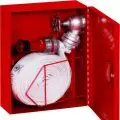A concrete wall intersected by a huge rust-colored "Solidarity" logo stood in a previously green square at the intersection of Swietokrzyska and Kopernika streets in Warsaw. The unveiling of the monument was attended by the leader of the Belarusian opposition, President-elect Svyatlana Tsichanouska.
Unveiled on the 32nd anniversary of Poland's first partially free elections, the monument was located on a stone square. Its main elements are a concrete wall into which fragments of the Berlin Wall with distinctive graffiti and a huge, spatial inscription of "Solidarity" have been incorporated. The movement's scaled-down, rust-colored logo floats above the square's surface and pierces the concrete barrier. Next to it, two quotes - statements by Ronald Reagan and John Paul II - are placed on the wall.
Photo: UM Warsaw
The Solidarity experience sustained and gave inspiration to Belarusians both when the Solidarity movement began under the Soviet Union and both now, when Belarusians are fighting a new dictatorship. However, never before in the history of Belarus have Belarusians and Belarusian women remembered Solidarity as they did during the past year, when the entire nation said a decisive "no" to the dictator.
Svitlana Tikhanouska
The creation of the monument was initiated by the Ronald Reagan Foundation. Preparations for its construction lasted for 7 years, and the unveiling was postponed several times. The construction cost 2 million zlotys - the monument was financed by the Foundation, while the Downtown District Public Land Board was responsible for the development of the square.
Photo by Kacper Kepinski
This will be one of the most eloquent, monuments to be erected in Warsaw in recent years.
Renata Kaznowska, deputy mayor of Warsaw
According to city officials, the monument is expected to be one of the more eloquent in Warsaw. It is certainly one of the more literal and overwhelming in scale. The author of the "S" logo, Jerzy Janiszewski, participated in its design. The huge, hovering "Solidarity" inscription stood in place of a pleasant square with benches, giving breath in this part of Downtown. The hitherto intimate space changed dramatically - a stone square surrounded by stairs replaced the greenery. It's hard to say whether the rust covering the movement's logo refers more to its working-class roots or the corrosion that afflicted the compound in its later years of existence.
Photo: UM Warsaw
The cutting of the wall is extremely literal. The monument leaves no room for interpretation or interaction. The impression of monumentality and detachment from its context is heightened by the slope and slope of the site - the monument towers over pedestrians and the neighborhood. Its political overtones are reinforced by two quotes - from Karol Wojtyla and Ronald Reagan, neither of whom was a member of Solidarity. It's a shame , then, that the commemoration of a grassroots, mass movement was done in a way so visually at odds with its formula and content.























